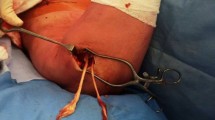Abstract
Nonoperative treatment of acute or chronic complete ruptures of the proximal hamstring tendons leads to functional impairment in sports activities. The objective of the study was to evaluate the functional status after primary and delayed surgical treatment including objective (isokinetic hamstring and quadriceps muscle testing, hamstring flexibility) and subjective parameters (overall satisfaction, postoperative sports level). A total of eight patients (six male, two female) with an average age of 40.0 years (range 23–60) were treated operatively by refixation of the ruptured tendons in anatomical position using a suture anchor system. Six patients were treated within 3 weeks after trauma, while two patients were operated after delayed diagnosis of more than 2 months. The average clinical follow-up was 33.3 months (range 12–59). Overall, at minimum follow-up of 20 months, all patients were satisfied with the functional outcome and would undergo operative treatment again. At follow-up, seven patients could return to their preinjury sports level. In two patients, however, we noticed a delayed return to preinjury sports level of more than 24 months. The peak torque of the operated hamstrings in isokinetic muscle testing was 88.3% (range 62.9–113.8), as compared to the contralateral extremity. The ratio of hamstring to quadriceps muscle strength was on average 0.55 (range 0.44–0.66; injured side) versus 0.61 (range 0.52–0.68; uninjured side). Measurement of hamstring flexibility showed no difference to the contralateral hamstrings. In cases of timely diagnosis, surgical treatment is the standard treatment for complete ruptures of the proximal hamstring tendons in patients with ambitions inclined toward sports. The suture anchor system implements an elegant and effective technique for the treatment of such lesions.









Similar content being viewed by others
References
Agre JC (1985) Hamstring injuries: proposed aetiological factors, prevention, and treatment. Sports Med 2:21–33
Barber FA, Herbert MA, Click JN (1996) Suture anchor strength revisited. Arthroscopy 12:32–38
Blasier RB, Morawa LG (1990) Complete rupture of the hamstring origin from water skiing injury. Am J Sports Med 18:435–437
Brunet ME, Kester MA, Cook SD, Leinhardt TM, Haddad RJ Jr (1987) Biomechanical evaluation of superficial transfer of the biceps femoris tendon. Am J Sports Med 15:103–110
Clanton TO, Coupe KJ (1998) Hamstring strains in athlete: diagnosis and treatment. J Am Acad Orthop Surg 6(4):237–248
Cross MJ, Vandersluis R, Wood D, Banff M (1998) Surgical repair of chronic complete hamstring tendon rupture in the adult patient. Am J Sports Med 26:785–788
Hamada G, Rida A (1963) Ischial apophysiolysis (IAL): report of a case and review of the literature. Clin Orthop 31:117–133
Ishikawa K, Kai K, Mizuta H (1988) Avulsion of the hamstring muscles from the ischial tuberosity. Clin Orthop 232:153–155
Klingele KE, Sallay PI (2002) Surgical repair of complete proximal hamstring tendon rupture. Am J Sports Med 30:442–447
Kujala UM, Orava S, Järvinen M (1997) Hamstrings injuries: current trends in treatments and prevention. Sports Med 23:397–404
Kurosawa H, Nakasita K, Nakasita H, Sasaki S, Takeda S (1996) Complete avulsion of the hamstring tendons from the ischial tuberosity. A report of two cases sustained in judo. Br J Sports Med 30:72–74
Martin TA, Pipkin G (1957) Treatment of avulsion of the ischial tuberosity. Clin Orthop 10:108–118
Metzmaker JN, Pappas AM (1985) Avulsion fractures of the pelvis. Am J Sports Med 13:349–358
Moeller K, Paul B (2001) Ruptur der kurzstreckigen Ursprungssehne des M. biceps femoris am Tuber ischiadicum. Dtsch Z Sportmed 52:104–106
Orava S, Kujala UM (1995) Rupture of the ischial origin of the hamstring muscle. Am J Sports Med 23:702–705
Sallay PI, Friedman RL, Coogan PG, Garret WE (1996) Hamstring muscle injuries among water skiers. Functional outcome and prevention. Am J Sports Med 24:130–136
Shea KP, O’Keefe RM Jr, Fulkerson JP (1992) Comparison of initial pull-out strength of arthroscopic suture and staple Bankart repair techniques. Arthroscopy 8:179–182
Schlonsky J, Olix ML (1972) Functional disability following avulsion fracture of the ischial epiphysis. Report of two cases. J Bone Joint Surg Br 54A:641–644
Thomsen NO, Jensen TT (1999) Late repair of rupture of the hamstring tendons from the ischial tuberosity—a case report. Acta Orthop Scand 70:89–91
Warner JJ, Parsons IM IV (2001) Latissimus dorsi tendon transfer: a comparative analysis of primary and salvage reconstruction of massive, irreparable rotator cuff tears. J Shoulder Elbow Surg 10:514–521
Acknowledgments
The authors thank Birgit Grimm, MSc, for performing the isokinetic muscle testing, and Christian Lattermann, MD, for review of the manuscript.
Author information
Authors and Affiliations
Corresponding author
Additional information
No author or related institution has received any financial benefit from research in this study
Rights and permissions
About this article
Cite this article
Brucker, P.U., Imhoff, A.B. Functional assessment after acute and chronic complete ruptures of the proximal hamstring tendons. Knee Surg Sports Traumatol Arthrosc 13, 411–418 (2005). https://doi.org/10.1007/s00167-004-0563-z
Received:
Accepted:
Published:
Issue Date:
DOI: https://doi.org/10.1007/s00167-004-0563-z




